This is a free fortnightly newsletter about the New Zealand Net.
If you would like to be notified by email when a new edition is published, please contact ZL1NZ.
Browse our Newsletter Archive and List of Net Tips.
Featured key
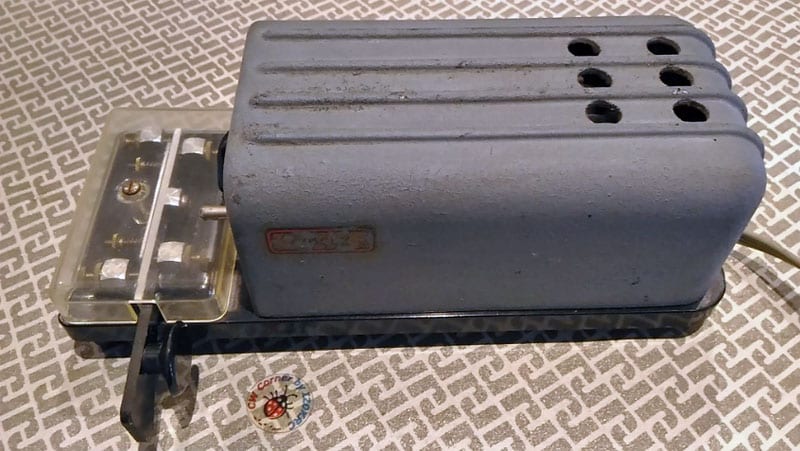
Mon-Key electronic keyer from 1948. Photo: IZ0KRC
Electronic keyers have been around a surprisingly long time. One of the earliest commercial models was the Mon-Key, introduced in February 1948 and made by the Electric Eye Equipment Company of Danville, Illinois, USA.
This keyer came with its own built-in key, which probably isn’t surprising, since “paddles”, as we call them today, were virtually unknown then.
The Mon-Key included a keying relay and a sidetone, but in other ways it was rather unsophisticated. It used a special resistive AC line cord, so replacing that with an ordinary cord would cause some excitement. Another bit of excitement would occur if you removed the plastic cover over the key to make adjustments without first unplugging the keyer from the AC. You had a 50% chance of discovering 115V on the key mechanism (depending on which way the two-conductor AC cord had been oriented in the North American style powerpoint).
For more on this intriguing keyer, see the video and advertisement later in this NZ Net News.
* If you have an interesting key for this feature, please send me a nice clear photo and a few words describing it.
Quick notes
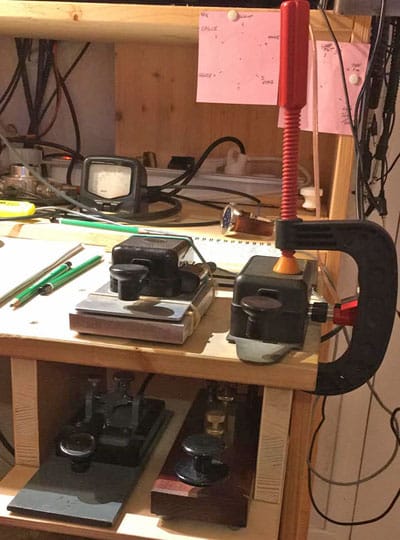 Are you tired of having to hold your key with one hand while keying with the other, just to keep the key from moving around on your desk? Good news! The Binford 6100 key stabiliser (pictured) will hold any key to any desk at speeds up to 40 wpm. And when you’re off the air, you can use your key stabiliser to laminate timbers up to 15cm thick!
Are you tired of having to hold your key with one hand while keying with the other, just to keep the key from moving around on your desk? Good news! The Binford 6100 key stabiliser (pictured) will hold any key to any desk at speeds up to 40 wpm. And when you’re off the air, you can use your key stabiliser to laminate timbers up to 15cm thick!
Why are we called hams? An NZ Net member asked me this a few days ago. My recollection was that wireless operators in the days of spark transmitters complained of interference from amateurs, and referred to them as hams, as in silly people or jokers. But, in fact, the term pre-dates wireless telegraphy and was used in the same disparaging way by railroad telegraphers when talking about unskilled operators. See the article from 1895 later in this NZ Net News.
4 years of NZ Net. Doesn’t time fly! NZ Net will be four years old on 25 March – but since that is a Saturday there will be no net session to mark the occasion. Nor will there be any cake. 🙁
Great to hear ZL1AYN checking into the net again recently. Welcome back Bob!
Always things to learn on the Net
 By Mike ZL1RA
By Mike ZL1RA
When Neil started the NZ Net in March 2019, he had three aims:
1. To encourage CW operation
2. To provide training and experience in CW net operation
3. To provide training and experience in CW message handling
In order to encourage CW operation covering all of New Zealand, the signals needed to be good enough to allow reliable skill development. The 80 metre band was selected and the frequency of 3535 kHz chosen.
After much experimentation I settled on a monoband inverted V dipole resonant at 3535 kHz, for which most operators in New Zealand give me signal reports of Strength 9. This has enabled me to concentrate on CW skill development, and not be too affected by adverse propagation.
The operation of a good CW net focuses on precision. Listening to a high-functioning CW net is a pure joy. The communication between stations is crisp and unambiguous. The use of Q codes saves time and increases efficiency by condensing whole sentences into just a few well chosen letters. Multiple check-ins get handled swiftly and efficiently and the Net Control performs liaison duties throughout the session, keeping track of all stations.
 One has to listen intently to the Net Controller’s instructions, as you may be called upon to QNG1, as I was for the first time, just this last week. QNG1 is a request for you to transmit a single request for check-ins from your station in case another station is not hearing the designated Net Control.
One has to listen intently to the Net Controller’s instructions, as you may be called upon to QNG1, as I was for the first time, just this last week. QNG1 is a request for you to transmit a single request for check-ins from your station in case another station is not hearing the designated Net Control.
Every evening I write a log of callsigns that have checked in and whether they have QTC (and for whom) or are QRU. I also make a note of any QNC which indicates a station wants to send a message to the whole group.
This is a very enjoyable activity in itself, associated with being a ‘regular’ operator as you get to know everyone in the group by callsign.
Traffic handling is excellent training for those who want to increase their CW speed, accuracy and precision. You may have noticed in the NZ Net News there is a regular column titled Morse Challenge. This is a great opportunity to decode a Morse recording, often from an historic or unusual source. The idea is to send in your answer by radiogram or email.
Since joining the NZ Net, my speed has increased to a comfortable 25 words per minute. Accuracy has improved with practice, but my lack of precision caught me out in my latest Morse Challenge reply over the Net. Instead of a “QSL” (“all received”) in reply, I got a “QTB”, meaning the receiving station wanted to check their word count against the Check Number in the message header.
There was only one word difference between the two counts, but this was enough for me not to receive the desired QSL. I had sent the radiogram at 25 words per minute (Speed), I hadn’t made any sending mistakes (Accuracy), so something had gone wrong with how I had transmitted the words/numbers (Precision).
After collaboration by email it was discovered I had written NR 101 but had actually sent NR101, thus reducing two words into one in the address (To) field. Therefore, and rightfully so, I did not receive a QSL for my Morse Challenge radiogram, but learned a very valuable lesson in being precise and careful in what is actually sent.
Another takeaway from that exercise was that, when writing a radiogram, the address field should only contain the addressee details, and any other information should be within the main body of the radiogram.
The sending and receiving of traffic is a true working partnership between operators for maximum efficiency.
The NZ Net is proving to be an excellent vehicle to participate in and develop CW knowledge and skill to an advanced level, while preserving an historic art.
Illustration: 1962 Heakthkit catalogue
CW lessons for new ops
By David ZL1DK
On-air and online lessons for CW beginners started on 13 March. Sent from South Auckland, the signals can be heard on the UHF FM National System (where available), on 3755 kHz and online via ZOOM. (For those wishing to listen via ZOOM, please contact Peter ZL1PX for access details.)
The lessons start with a character speed of 19 Words Per Minute but by using Farnsworth Spacing, the text speed is just 6 wpm. As time moves on, we will increase the text speed by reducing the spacing until we reach around 13 wpm in December.
The CW is sent on Mondays, Tuesdays, Thursdays and Fridays, starting at 7.15pm on Mondays, and at 7.30pm the other days.
Sessions last around 35-45 minutes. Text is available to all for these lessons just ask. At the start of each session, we ask for check-ins and at the end of the session, if you wish, you can tell us how you did – good, bad or somewhere in the middle. No one will be asked to read back what they received or put under any pressure at all.
So far, I have three operators sending the CW, Rob ZL1RJS, Peter ZL1PX and me.
We use Gary Bold’s Teach software which has been modified by Andrew, ZL1AF.
A message every three seconds
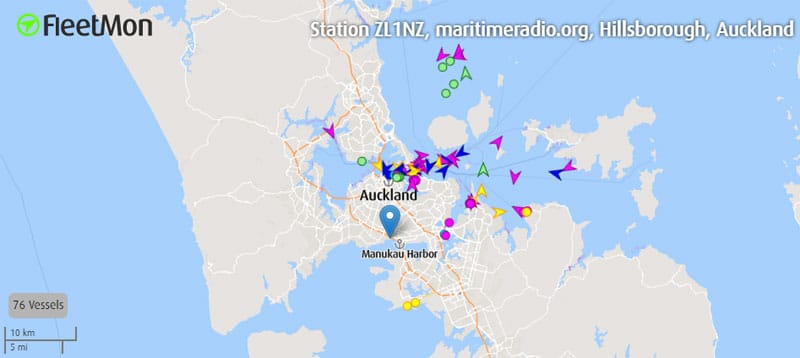
Vessels being tracked via AIS at ZL1NZ, 12 Mar 2023
By Neil ZL1NZ
During a typical day at ZL1NZ, more than 26 thousand radio messages are received. One every three seconds.
Fortunately, I only need to grab a pen and radiogram form for one or two of them!
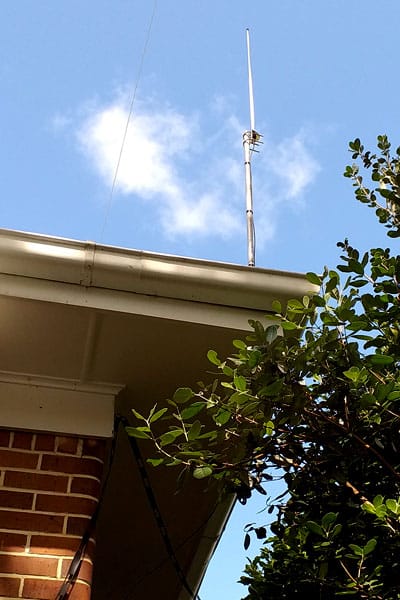
All the others are position reports from ships in my area, sent as data via VHF radio, using AIS (the Automatic Identification System).
AIS signals are sent automatically by ships – usually once or twice per minute – and can be received by other vessels (e.g. for collision avoidance), terrestrial stations and satellites. Satellites are great for vessels far from land, but the updates are less frequent and less reliable than those received at terrestrial stations.
My receiver easily picks up stations 60 nautical miles away, so has good coverage of the Manukau and Waitemata Harbours plus the Hauraki Gulf. It impressed me by tracking one containership to a range of 80 nautical miles (150km) before losing it well east of Coromandel Peninsula.
The receiver and vertical dipole aerial (pictured) were supplied by FleetMon and connect via the internet to their servers. Anyone can visit their website and see near real-time positions reports of vessels all over the world.
If you host a FleetMon receiver, they lend you the equipment and also upgrade you from a free account to a professional account, giving access to more information and tools on their website.
FleetMon is currently looking for more sites in New Zealand and Australia. If you’re interested, you can find details on their website or email me for contact information. If you already have an AIS receiver, they’ll let you know how to connect it to their system.
New book tackles CW in depth
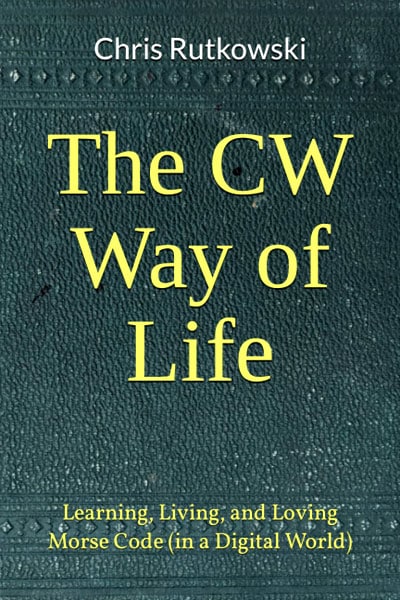 The CW Way of Life: Learning, Living, and Loving Morse Code (in a Digital World) by Chris Rutkowski NW6V is a book I’ll definitely be adding to my collection.
The CW Way of Life: Learning, Living, and Loving Morse Code (in a Digital World) by Chris Rutkowski NW6V is a book I’ll definitely be adding to my collection.
Chris is an engaging writer, if the Prelude to CW Way of Life is any indication. I urge you to pop over to that big online store and read the Prelude right now…
OK, you’re back. Wasn’t that a beautiful tale, packed into just four pages?
As for the rest of the book, here’s the publisher’s blurb:
The CW Way of Life (CWOL) provides a complete, self-contained Morse code learning system that requires no computers or special equipment. It combines techniques dating back to the time of Morse with modern deliberate training principles to create a programme like no other. If mastering Morse isn’t on your agenda, you can read along like it’s a Rick Steves guide to Morseland. Or, you can roll up your sleeves, do the drills, and set yourself on a 175-year-old path to Morse mastery. It’s all good.
But this is more than a Morse “how-to” book – it’s a deep dive into how it works, and you can’t study how it works without looking at how you work. Learning the Morse alphabet provides a unique window into how your brain turns sensations into thoughts.
After an in-depth look at the invention, psychology, and physics of “Morse,” CWOL divides the subject into seven parts that build on each other. Not just for beginners, The CW Way of Life contains information of use to any user of Morse.
- The Key – Learn to operate a standard straight key with significantly reduced risk of the dreaded Telegrapher’s Paralysis – aka “glass arm” that afflicted operators for decades.
- The User – Learn to adjust the most important component in the system, you.
- Code Talking – Leverage the power of your existing language system to learn the music of Morse – before the code is known – just as babies learn to speak.
- Double-D Notation (dD) – Learn to read and write Morse characters off a page like music. It’s easy.
- The Code – Drill your way to memorizing Morse on every I/O channel.
- The Lingo – Learn the “Language of Morse,” including definitions, grammar, and etiquette – which can be practiced in the ABCs. No Morse needed.
- Advanced Key Training – Focused drills teach serious students how to develop and hone their skills.
Have you read The CW Way of Life? If so, please send your comments.
The earliest hams?
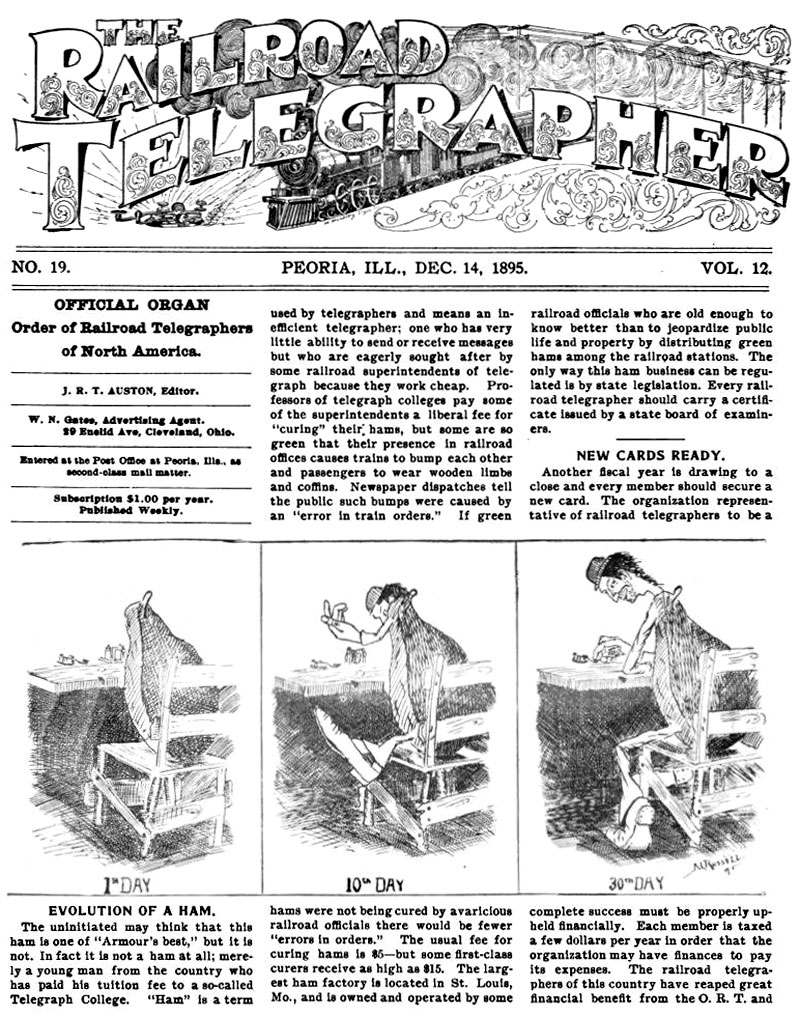
* Armour was a meat packing company founded in Chicago in 1867.
Morse challenge
This one is simple. You just need to answer the question, contained in the audio recording:
Please send your answer via radiogram or email to ZL1NZ.
Answer to previous Morse challenge
The Net Control Station in our recording was ZM75BRL/2 (marking the 75th Anniversary of the Association of Blind Citizens of NZ) and the operator was Dave (ZL4LDY). Correct answers were received from VK3DRQ, ZL1ANY, ZL1AYN, ZL1BBW (who answered while in hospital – what dedication!), ZL1RA and ZL2GVA.
Video: The amazing Mon-Key
Advertising archive
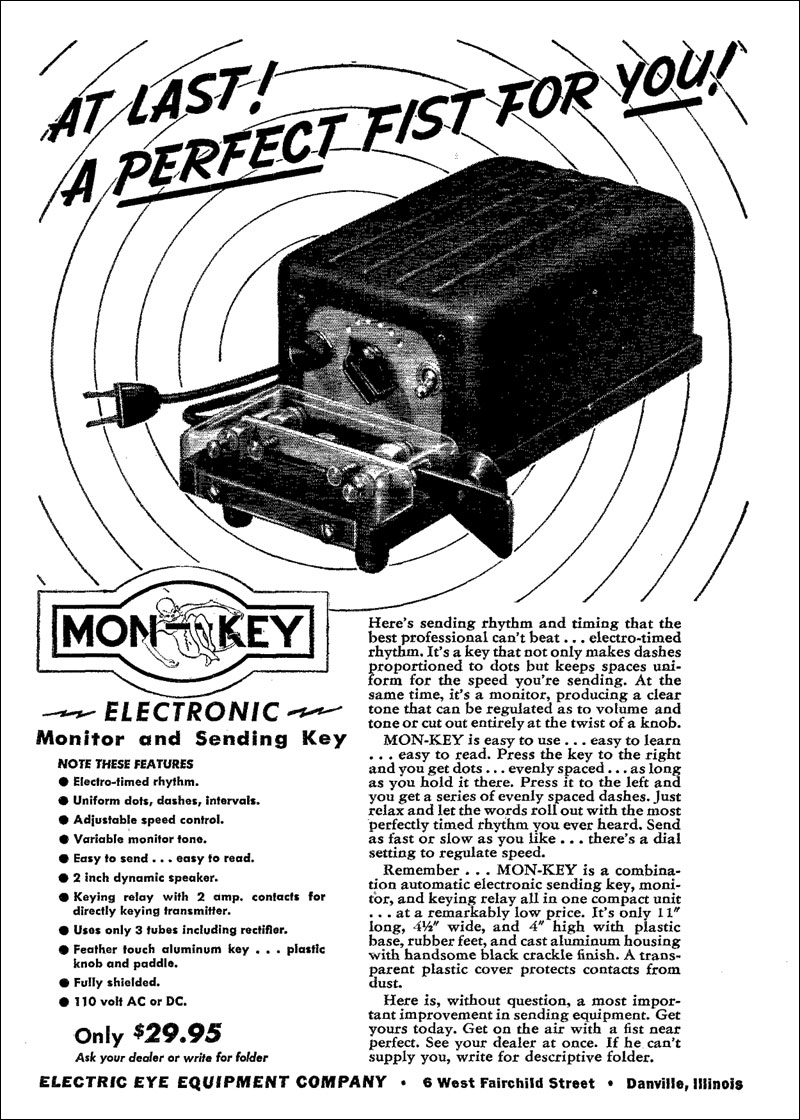
QST magazine, February 1948
Suggestions?
If you have suggestions on how to make the NZ Net better, or things you’d like to see covered in these updates, please contact ZL1NZ. You might even like to write something for the newsletter.
Thanks for reading, and I hope to hear you soon on the NZ Net!
—
Neil Sanderson ZL1NZ, Net Manager
New Zealand Net (NZ NET)
3535.0 kHz at 9pm NZT Mon-Fri


